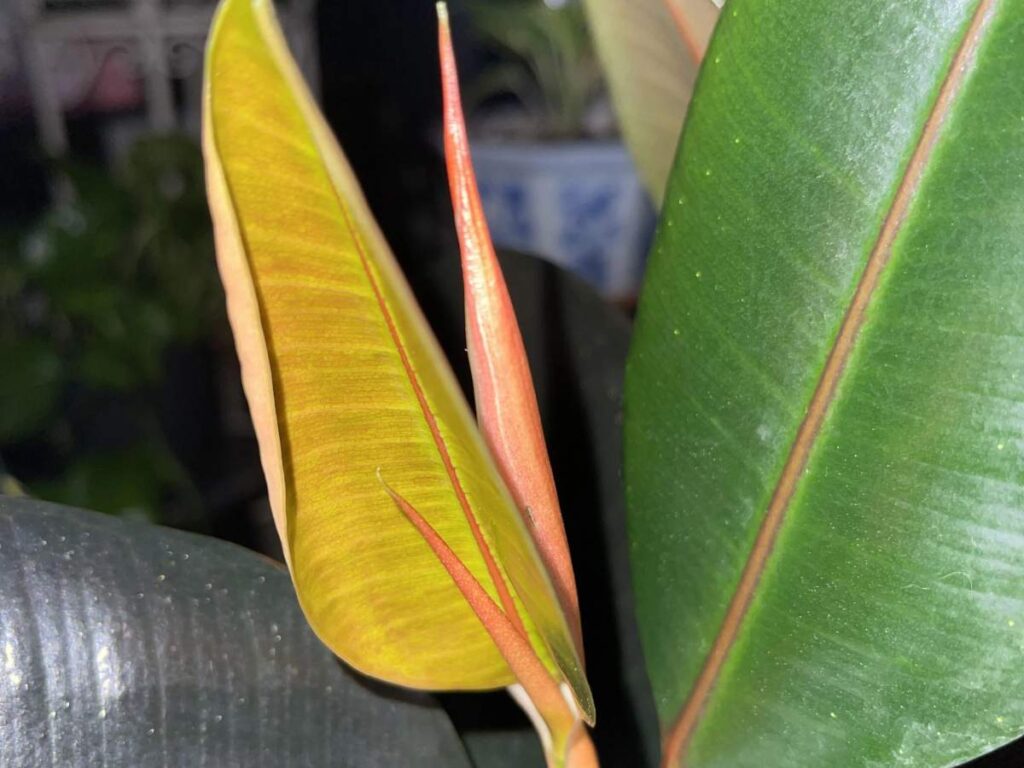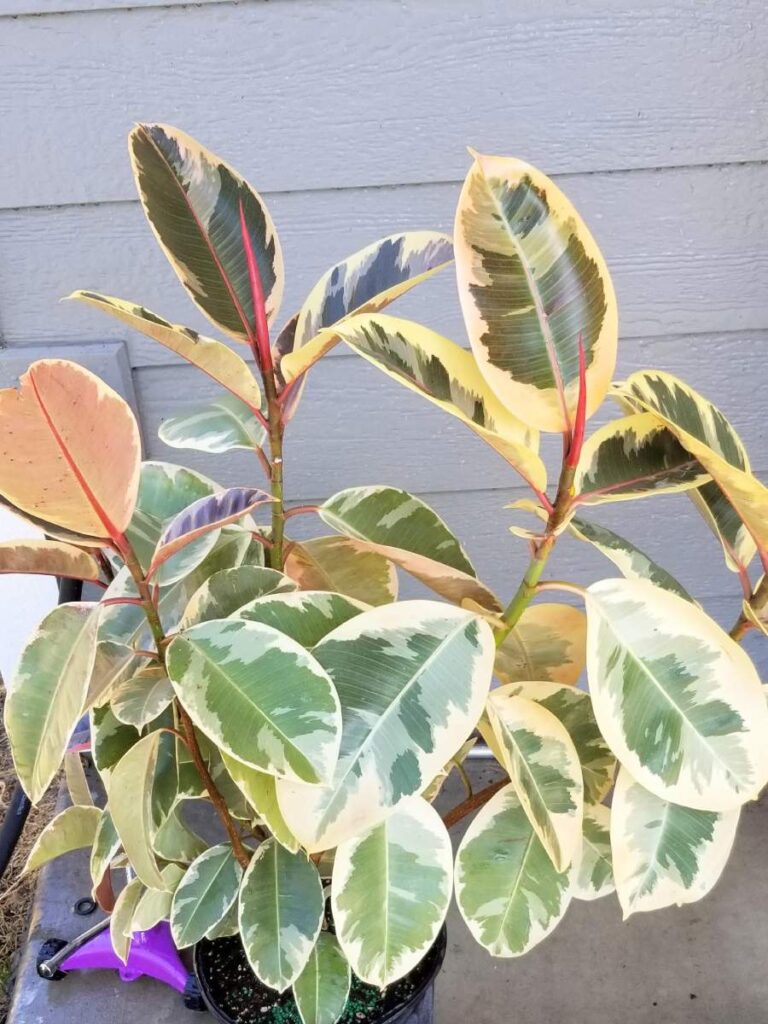Have you ever been captivated by the beauty of a rubber plant (Ficus elastica) but wondered if they can actually flower? The answer may surprise you; not only do rubber plants have the potential to bloom, but their flowers are also quite stunning.
In this article, I’ll explore why some rubber plants don’t normally flower and how you can encourage your own to produce blooms. So let’s get started!
Here’s Do Rubber Plants Flower?
The rubber plant (Ficus elastica) can flower when grown in the right conditions. When a rubber plant matures, white blooms appear in clusters at the tips of its stems. Through proper care or external triggers, some rubber plants can be encouraged to flower more often.

Factors Affecting Rubber Plant Flowering
Lighting and temperature play an important role in the flowering of a rubber plant. If you keep your plant in direct sunlight for long periods of time, it can cause leaf burn and prevent blooms from forming. On the other hand, too little light may stunt growth and inhibit flowers from opening up.
Temperature also affects how well your rubber plant thrives; temperatures below 50°F (10°C) can be harmful, while temperatures above 95°F (35°C) should be avoided as well.
Additionally, adequate watering is essential for healthy rubber plants and successful flowering. Water when the soil starts to feel dry, but don’t allow it to become soggy; this could lead to root rot, which will make it difficult for the plant to bloom.
Also, fertilizing with a balanced fertilizer every two weeks during spring and summer helps promote growth and encourages flowering later in the season. Taking all these elements into account will help ensure that your rubber plant blooms beautifully!
How to Identify a Rubber Plant in Bloom?
When it comes to identifying a rubber plant in bloom, you’ll want to know what to look for. Rubber plants are perennial flowering plants that produce small white or yellow flowers with five petals each. These blooms typically appear during the summer months and can be found on the tips of branches near the leaves.
To spot these beautiful blooms, take a closer look at your rubber plant’s foliage. If you see clusters of tiny buds forming along the stems and leaves, chances are they will soon open into flowers!
Look out for star-shaped bracts as well; these help attract pollinators like bees, which will ultimately fertilize them.
If you’re lucky enough to have a mature rubber plant, then its long, waxy green leaves may also provide clues that it’s ready to flower. When this happens, expect an explosion of color in your home!
Helping Rubber Plants to Flower
In fact, over 85% of indoor rubber plant owners have reported seeing flowers on their plants. If you want to help your own rubber plant bloom, it’s all about the right care and attention! Here are four steps to take:
- Make sure the potting soil is well-draining so excess water doesn’t stay around the roots.
- Keep temperatures between 65 and 85 degrees Fahrenheit for optimal growing conditions.
- Place your rubber plant in an area with bright but indirect sunlight; too much sun will damage its leaves.
- Feed regularly during the spring and summer months, when growth is most active.
These simple tips should help make sure your rubber plant has enough nutrients and light to flower successfully! With proper care, you should start noticing buds blooming soon after following these instructions; just remember not to overwater it or place it in direct sunlight. Your beautiful rubber plant won’t be far away!

Light Requirements for Flowering
It’s like a race between the sun and a rubber plant. The sun is determined to give off its powerful rays, while the rubber plant desperately wants to blossom in response. It can be difficult for them both, as they need each other to make it happen.
Light requirements are key when it comes to helping a rubber plant flower. Without enough light, the poor thing won’t have enough energy or resources to produce flowers; however, too much direct sunlight will cause scorching on the leaves.
So finding that perfect balance of conditions is essential if you want your precious rubber tree friend to show off its beauty! But if you get it right, ah, then you’ll be rewarded with stunning blooms full of life and color!
Temperature Requirements for Flowering
Temperatures are key when it comes to making sure your rubber plant blooms beautifully:
For ideal flowering conditions, the temperature needs to be between 65-85°F (18-29°C): If temperatures drop below 60°F (15°C), flowering will stop and growth may slow down. At temperatures higher than 86°F (30°C) for more than two weeks, buds can turn brown or drop off before they open.
Rubber plants also require humidity levels of at least 40%: This is because most homes naturally have very low humidity levels that can cause stress on your plant, resulting in drooping leaves and stunted growth.
You can raise the humidity around the plant by misting it with water often or putting a humidifier in the room where it lives.
Water Requirements for Flowering
When it comes to watering rubber plants, they require a certain amount of moisture in order to flower. The ideal soil should be kept moist but not soggy. It’s important to water the plant regularly and avoid letting the soil dry out completely; otherwise, flowering won’t occur.
To determine if your rubber plant needs more water, check the top inch or so of soil; if it feels dry, you’ll need to add some extra moisture.
It’s also worth noting that too much water can cause root rot, so be careful with your watering schedule and make sure not to overwater your rubber plant.
If there appears to be standing water at the bottom of the pot, this could indicate that you are giving it too much and will need to reduce how often you’re watering for successful blooms!
Fertilizer Requirements for Flowering
Fertilizer requirements for flowering are like a gardener’s secret weapon. They’re the tools that bring vibrancy and life to any garden, giving it the oomph it needs to really shine. Just like a chef adds spices to food, adding fertilizer is how you give your plants what they need to grow beautiful blooms:
- Compost or manure is a great source of nutrients that helps with drainage and increases fertility in the soil.
- Slow-release fertilizer helps keep levels of essential minerals consistent over time.
- Water-soluble fertilizers provide an immediate boost of nutrition but have to be reapplied regularly.
When used properly, these fertilizers can transform any rubber plant into something truly remarkable—one capable of producing lush foliage and stunning flowers that will last throughout the season.
With just a bit of extra care and attention, your rubber plant can become something special—so don’t forget those magic ingredients!
Pruning and Deadheading for Flowering
It’s like going for a walk in the park. You come upon a row of rubber plants, each standing tall and proud with glossy, dark green leaves rustling ever so slightly in the breeze. But something is missing; none of them are flowering. Pruning and deadheading could be the keys to unlocking this hidden beauty.
Let me explain: Pruning helps stimulate growth by encouraging new shoots that will flower eventually. Deadheading removes spent blooms to make way for new ones – it’s almost like giving your plant a fresh start! Here are a few steps you can take to get better results when pruning and deadheading:
- Trim away any wilted stems or flowers at their base.
- Cut off faded flower heads as soon as possible.
- Use clean garden shears to avoid spreading disease.
- Leave only healthy buds on the stem.
- Avoid removing more than 25% of your plant’s foliage at once.
By taking these simple actions, you’ll give your rubber plants an opportunity to reach their full potential, resulting in beautiful clusters of flowers that fill the air with sweet aromas.
Common Diseases that Affect Flowering
It’s not all sunshine and roses with rubber plants. Like most other plants, they can be affected by certain diseases that may prevent them from flowering or even reduce their lifespan. Let’s take a look at some of the common diseases that affect flowering in rubber plants.
The first is root rot, which happens when there is too much water around the roots. This causes the plant to become weak and unable to absorb nutrients properly, resulting in stunted growth and limited flowers.
Another common problem is bacterial blight, which affects the leaves of the plant and results in yellow spots on them. It also reduces blooming potential significantly.
Finally, fungal infections such as powdery mildew can cause discoloration of foliage and limit flower production due to nutrient deficiencies caused by it.
Fortunately, these diseases can usually be prevented with proper care and maintenance of your rubber plant.
Make sure you’re providing adequate drainage for its soil so that water doesn’t accumulate around the roots; this will help avoid root rot problems.
Additionally, keep an eye out for any signs of distress on your plant’s leaves; if spotted early enough, you might be able to tackle any potential bacterial or fungal issues before they get worse.
Common Pests that Affect Flowering
Pests like aphids, mites, and mealybugs are some of the most common culprits when it comes to plant damage. These insects feed on the leaves, stems, and flowers of many popular houseplants, including rubber plants.
If you suspect there might be an infestation in your home or garden, look for signs such as yellow spots on the leaves or white webbing along their stems.
You’ll also want to keep an eye out for ants crawling around your plants—they often indicate a pest problem too!
To tackle any issue head-on, try using natural remedies like neem oil or insecticidal soap sprays. Both options are safe yet effective ways to stop these bugs from damaging your beloved plants.
When to Expect Rubber Plant Flowering
Rubber plants are like a beacon of hope, promising beauty and respite in this chaotic world. As such, it’s no surprise that many people want to know when they can expect these hardy plants to flower. Well, the answer isn’t quite as simple as one might think:
It all depends on how long you’ve had your rubber plant. If it is young (under 3 years old), then chances are you won’t see any flowers growing from its leaves anytime soon, but don’t give up hope!
On the other hand, if your rubber plant has been with you for five or more years, then there’s an excellent chance you will witness blooming buds before too long.
Additionally, the time of year also plays a role; late winter/early spring is usually best for encouraging flowering in mature rubber plants.
To make sure yours gets plenty of light during this period, consider moving it closer to a window where it can get maximum exposure.
So while patience may be necessary in some cases, it doesn’t mean that your beloved rubber plant won’t eventually reward you with beautiful blooms. Just keep tending to it with care and attention, and you’ll be rewarded handsomely!
Propagating Rubber Plants from Cuttings
Who would have thought that something as seemingly mundane and unassuming as a rubber plant could have so much potential? Yes, it turns out that these plants can be propagated from cuttings.
And while they may not often bloom, I’m sure you’ll find other ways to enjoy their beauty in your home.
Propagating rubber plants is relatively easy and requires only the simplest of supplies. All you need is some rooting hormone and clean clippers or scissors to take the cutting; then, place the cutting into a pot with moist soil.
When new growth appears on the stems in late spring or early summer, this is the best time to take cuttings. After about two months’ wait, you should see roots emerging from your cuttings.
Finally, water thoroughly and keep an eye out for any pests or diseases that might affect them—but rest assured, this isn’t usually a problem!
So why not try your hand at propagating a rubber plant? With just one cutting, you can start growing an entirely new plant—what an exciting experience! You never know where it might lead.
Conclusion
The rubber plant is a beautiful and popular houseplant, but it’s not always easy to get it to flower. While most plants will bloom if the conditions are favorable, there are some factors that can influence flowering in rubber plants. With proper care, however, you can help ensure that your rubber plant blooms consistently.
Light requirements should be carefully considered when trying to encourage flowering in rubber plants. Make sure that they’re getting enough of both direct and indirect light during the growing season. It’s also important to keep an eye out for common diseases and pests that could affect their ability to produce flowers.
Propagating from cuttings is another great way to increase the chances of your rubber plant flowering. Even if you don’t have any luck getting your current specimen to bloom, you can use the cutting as a fresh start!
Don’t give up hope on seeing those gorgeous blooms—with patience, time, and effort, you’ll eventually be rewarded with lovely flowers on your rubber plant.







